Concrete staining Atlanta has emerged as a transformative trend in interior design, enhancing concrete flooring to be both functional and aesthetically appealing. As homeowners and businesses increasingly seek unique and durable flooring options, the importance of concrete staining contractors has become more pronounced.
This article delves into the concept of concrete staining, highlighting its versatility, cost-effectiveness, and the various types of stains available, including the use of concrete overlay for enhanced aesthetics.
Furthermore, it provides guidance on selecting the appropriate contractor and outlines what to expect during the staining process, ensuring that your floors not only exhibit a polished appearance but also endure over time.
The Rise of Concrete Staining Contractors
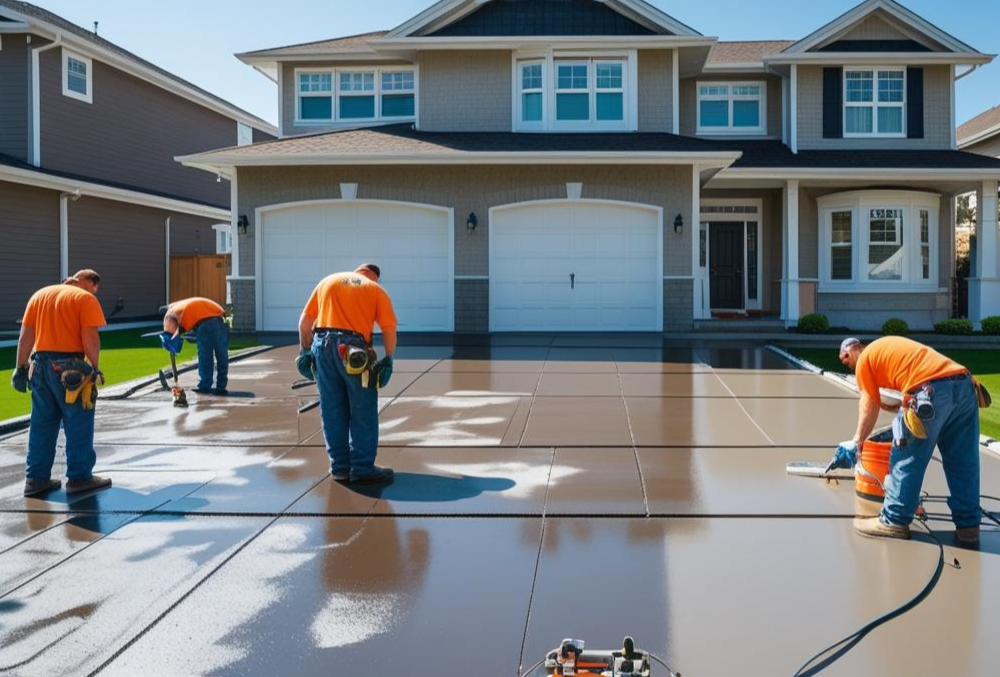
In recent years, there has been a marked increase in the number of concrete staining contractors specializing in the transformation of standard concrete surfaces into visually appealing and durable flooring solutions, reflecting evolving flooring trends in residential concrete staining.
This trend indicates a growing demand for both aesthetic and functional enhancements in residential and commercial spaces, as property owners seek to improve the interior design of their environments.
The versatility of stained concrete floors, combined with their affordability and low maintenance requirements, has rendered them a favored option for New York lofts and other modern architecture and other contemporary architectural developments.
Engaging the services of skilled contractors allows homeowners to implement unique designs and impactful upgrades that significantly enhance their interior aesthetics.
What is Concrete Staining?

Concrete staining is a technique that enhances the aesthetic appeal of concrete surfaces, providing a diverse array of colors, textures, and decorative effects that can complement various interior design schemes, making it a popular choice for home improvements and remodeling projects.
This method not only revitalizes bland concrete but also contributes to the durability and resilience of surfaces subjected to heavy foot traffic, offering affordable flooring solutions for home renovations.
Within the realm of concrete staining, several options are available:
- Acid-based stains: These stains create rich, translucent tones and are favored for their ability to penetrate the concrete, chemically reacting to produce a range of shades, perfect for high-impact upgrades.
- Water-based stains: These stains offer a broader color palette and are easier to apply and clean, making them a popular choice among DIY enthusiasts, specifically for DIY maintenance and homeowners guide.
The choice between these types can significantly impact the overall aesthetics of a space.
Whether one prefers the rustic elegance of acid stains or the vibrant versatility of water-based stains, the result enhances the ambiance while maintaining an eco-conscious approach, reflecting both style and sustainability, incorporating eco-friendly staining methods and sustainable design.
How Do Concrete Staining Contractors Work?
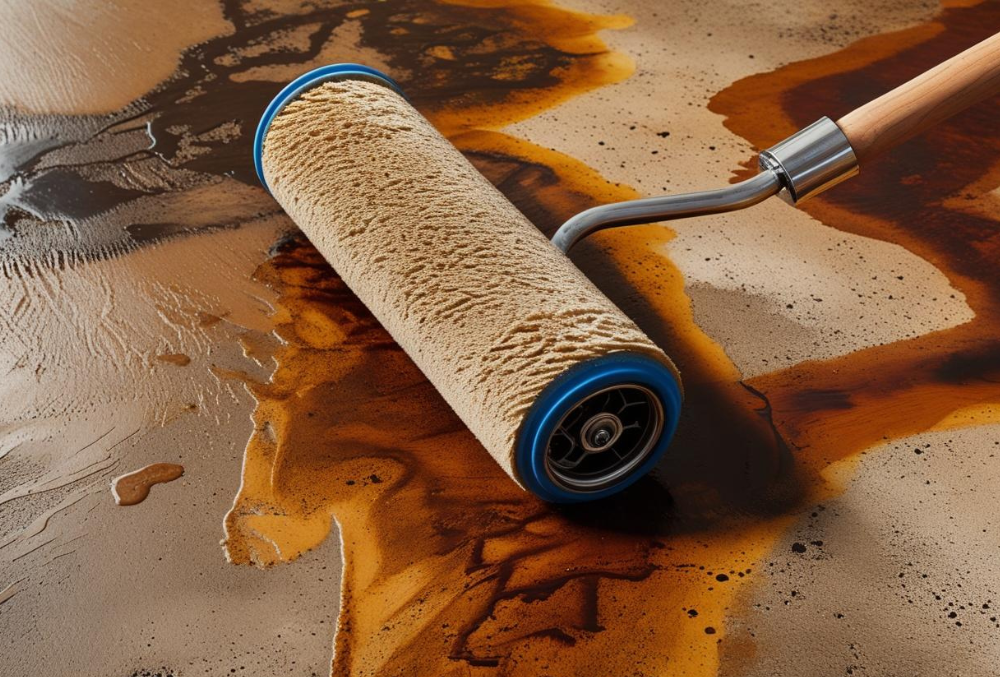
Concrete staining contractors are essential in the transformation of existing concrete surfaces through a systematic process that encompasses consultation, preparation, application, and finishing.
These professionals begin by evaluating the condition of the concrete and engaging in discussions regarding design choices and finish options that align with the client’s vision for aesthetic enhancements.
They utilize their expertise in construction quality and their knowledge of various materials to ensure a successful outcome, whether for a residential renovation or a commercial space refurbishment. With a strong emphasis on durability and maintenance requirements, they also offer valuable insights into DIY maintenance practices to achieve long-lasting results.
What Are the Steps Involved in Concrete Staining?
The process of concrete staining entails several critical steps that ensure a high-quality finish and enhanced aesthetics for decorative concrete surfaces. Initially, the concrete must be thoroughly cleaned and prepared to eliminate any dirt, grease, or existing finishes that could impede the staining process.
To achieve optimal results, it is essential to adhere to a systematic approach.
- First, assess the condition of the concrete to determine the appropriate cleaning methods. This may involve pressure washing or utilizing a concrete cleaner to remove stubborn stains.
- Proper preparation is fundamental for successful staining, as any residue left on the surface can result in uneven color application.
When selecting the stain, it is important to consider factors such as the intended use of the area, the desired aesthetic, and the environmental conditions. The application of the stain must be executed meticulously, as the technique significantly influences the final outcome.
Whether employing a sprayer or brush, it is crucial to work in sections to ensure even coverage and prevent lap marks.
Following the drying of the stain, the application of a high-quality sealant is essential, enhancing the durability of concrete and ensuring long-lasting floors.
This step not only protects the stain from wear and tear but also enhances the vibrancy of the color and provides a water-resistant finish. Regular maintenance can further extend the life of the stained surface, ensuring it remains visually appealing for years to come.
Why Choose Concrete Staining for Your Floors?
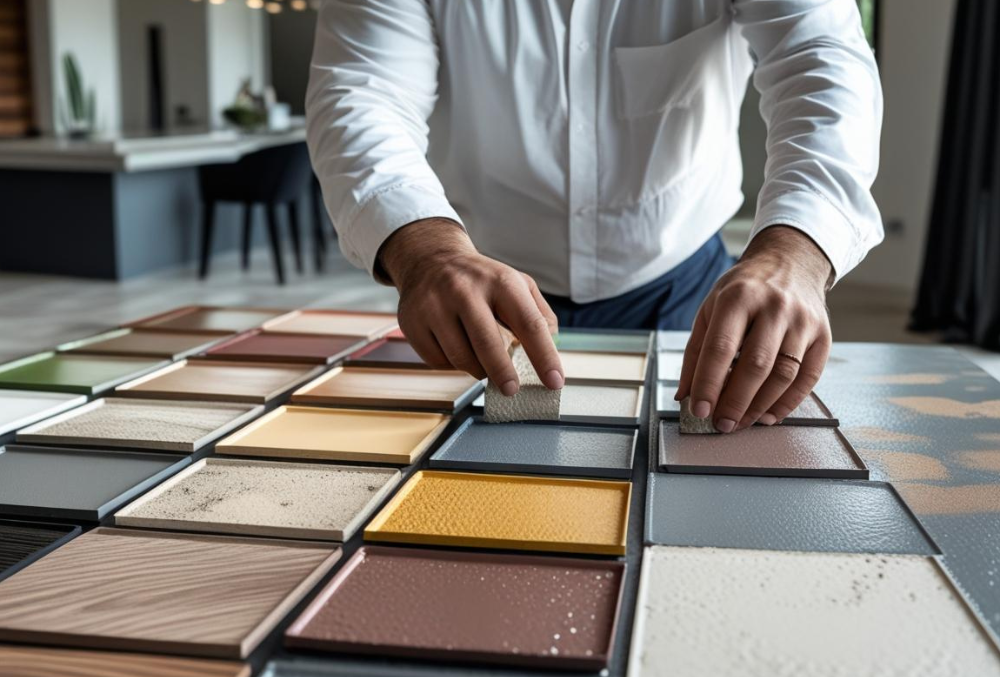
Concrete staining has become a preferred option for flooring because of its distinct advantages, including durability, low maintenance requirements, and cost-effectiveness. This makes it an ideal solution for both residential and commercial environments.
Homeowners and interior designers are increasingly acknowledging the versatility of stained concrete floors, which can be tailored with a range of colors, textures, and decorative patterns to complement contemporary architecture and design trends.
When applied correctly, stained concrete not only enhances the aesthetic appeal of a space but also offers a resilient surface that endures over time.
Versatility in Design
One of the most compelling reasons to opt for concrete staining is its exceptional versatility in design, enabling homeowners to create personalized solutions that reflect their unique style and preferences.
With options that range from geometric designs to intricate decorative patterns, stained concrete can seamlessly integrate into various interior aesthetics, making it suitable for a wide array of environments, from industrial settings to contemporary residential spaces.
This adaptability not only enhances visual appeal but also provides a multitude of flooring options that cater to diverse design trends.
This extensive range of possibilities offers both aesthetic diversity and functional benefits that homeowners find highly valuable.
For those aiming to make bold statements, a stained concrete floor can incorporate unique patterns such as:
- Swirling effects that replicate the look of natural stone or marble
- Color gradients for a softer, multi-toned appearance
- Custom logos for commercial spaces to reinforce branding
The stain can be applied in various intensities, ranging from transparent hues to vibrant colors, allowing individuals to select finishes that best suit their living spaces.
Durable and Long-lasting
Stained concrete is widely recognized for its exceptional durability, making it an ideal flooring solution for high-traffic areas in both residential and commercial environments.
The versatility of stained concrete is evident in its ability to maintain an attractive appearance while withstanding the challenges posed by heavy foot traffic. This flooring option contributes to a safer environment by minimizing the risks associated with slips and falls, due to its textured finish.
Routine maintenance is minimal; simple sweeping and occasional mopping are generally sufficient to preserve its pristine condition. For those mindful of environmental impacts, eco-friendly stained concrete options are available, formulated with low-VOC materials that enhance indoor air quality.
These sustainable solutions demonstrate a commitment to durability while addressing both aesthetic and functional needs in a variety of settings.
Low Maintenance
One of the primary advantages of stained concrete floors is their low maintenance nature, rendering them an appealing option for both busy homeowners and businesses.
Unlike traditional flooring alternatives that may necessitate regular upkeep or the use of specialized cleaning products, stained concrete merely requires periodic cleaning and occasional resealing to maintain its appearance and durability.
This cost-effective benefit allows property owners to enjoy aesthetically pleasing flooring without the persistent concern of extensive maintenance or repair costs.
To ensure these surfaces maintain their optimal appearance, property owners should adhere to several straightforward cleaning recommendations.
Regularly sweeping or vacuuming the floor can help eliminate dirt and debris that may scratch the surface, while utilizing a pH-neutral cleaner with a damp mop will effectively keep the concrete polished without causing any damage.
The necessity of resealing these floors every one to three years cannot be overstated, as it safeguards the stained surface from wear and enhances its visual richness.
Cost-effective and Affordable Options
Concrete staining represents a highly cost-effective flooring solution that delivers substantial value without compromising on quality or aesthetics.
The initial investment in stained concrete often proves to be more economical compared to other flooring options such as hardwood or tile, particularly when taking into account the long-term benefits of durability and low maintenance requirements.
This feature makes stained concrete an excellent choice for homeowners aiming to achieve impactful upgrades in their home renovations while remaining within budgetary constraints.
When assessing the overall costs associated with various flooring materials, stained concrete distinguishes itself through its exceptional resilience and ease of maintenance.
Unlike tile or luxury vinyl, which may necessitate frequent replacements or extensive upkeep, stained concrete maintains its integrity for many years, resulting in savings in both time and financial resources related to repairs.
What Are the Different Types of Concrete Stains?
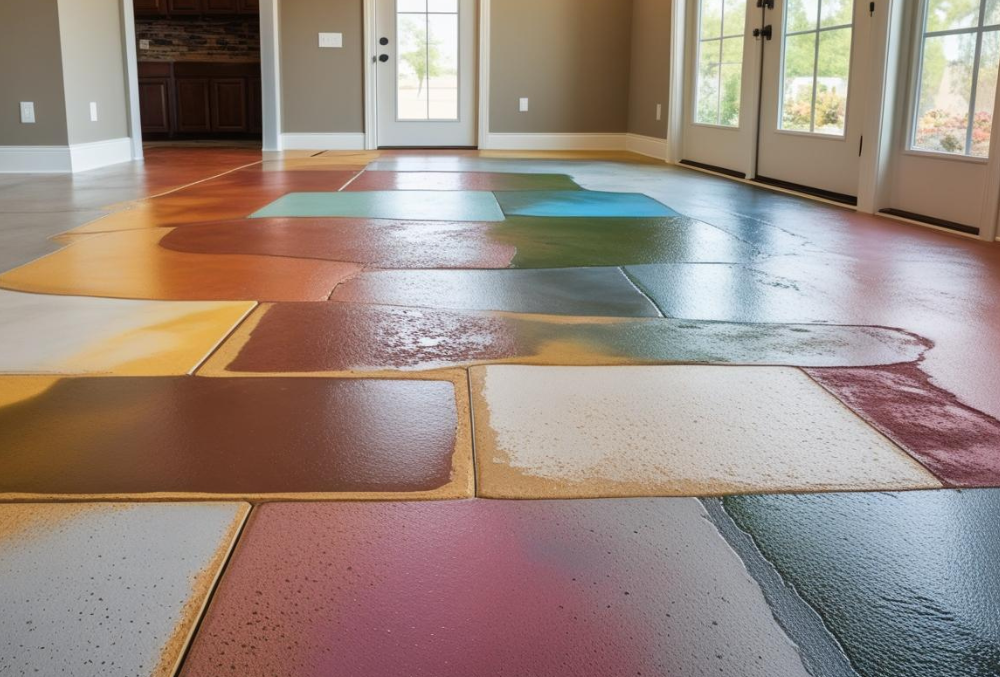
In the realm of concrete staining, various types of stains are available, each presenting unique characteristics and aesthetic possibilities for homeowners and designers.
The two main categories are acid-based stains and water-based stains, both of which offer distinct decorative effects capable of transforming ordinary concrete surfaces into striking focal points.
A thorough understanding of the differences between these stain types is essential for making informed decisions that align with one’s renovation objectives and design preferences.
Acid-based Stains
Acid-based stains are a prevalent choice for concrete staining due to their capacity to produce rich, translucent colors and a distinctive variegated appearance that closely resembles natural stone.
These stains undergo a chemical reaction with the minerals present in the concrete, resulting in highly durable and long-lasting finishes that resist fading and wear over time.
With a diverse array of color options available, acid-based stains provide homeowners and contractors the flexibility to create visually striking effects suitable for both residential and commercial environments.
One of the notable attributes of acid-based stains is their exceptional durability, which renders them ideal for high-traffic areas such as patios, driveways, and retail spaces. Along with offering an aesthetically pleasing finish, these stains enhance the longevity of surfaces, presenting a maintenance-friendly alternative to traditional paints or dyes.
Key benefits include:
- Weather Resistance: Acid-based stains are capable of withstanding outdoor elements without significant degradation.
- Low Maintenance: The surface is easy to clean and typically requires resealing only every few years.
- Eco-Friendly Options: Numerous types of acid stains are formulated with environmentally safe components.
In conclusion, the application of acid stains not only elevates visual appeal but also adds considerable value by transforming ordinary concrete into sophisticated surfaces.
Water-based Stains
Water-based stains present an environmentally friendly alternative to traditional acid-based stains, offering a diverse array of vibrant colors and a user-friendly application process. These stains are formulated without harsh chemicals, rendering them suitable for indoor applications where air quality is a critical concern.
Along with their eco-friendly characteristics, water-based stains facilitate easy clean-up and feature quicker drying times, making them a favored option among homeowners and DIY enthusiasts seeking an effective and safe method to enhance their concrete surfaces.
The benefits of water-based stains extend well beyond their environmentally conscious formulation.
- Versatile Applications: These stains can be effectively applied to various surfaces, including wood, concrete, and masonry.
- Color Variety: With an extensive palette of colors available, these stains cater to a wide range of aesthetic preferences, enabling users to achieve their desired visual outcome.
- Low Odor: Unlike traditional stains, water-based stains produce a low odor, thereby minimizing disruption and ensuring a more pleasant working environment.
- Durability: Once cured, water-based stains provide a long-lasting finish that can endure significant wear and tear.
Collectively, these attributes make water-based stains not only a practical choice for enhancing aesthetics but also a responsible option for environmental stewardship.
How to Choose the Right Concrete Staining Contractor?
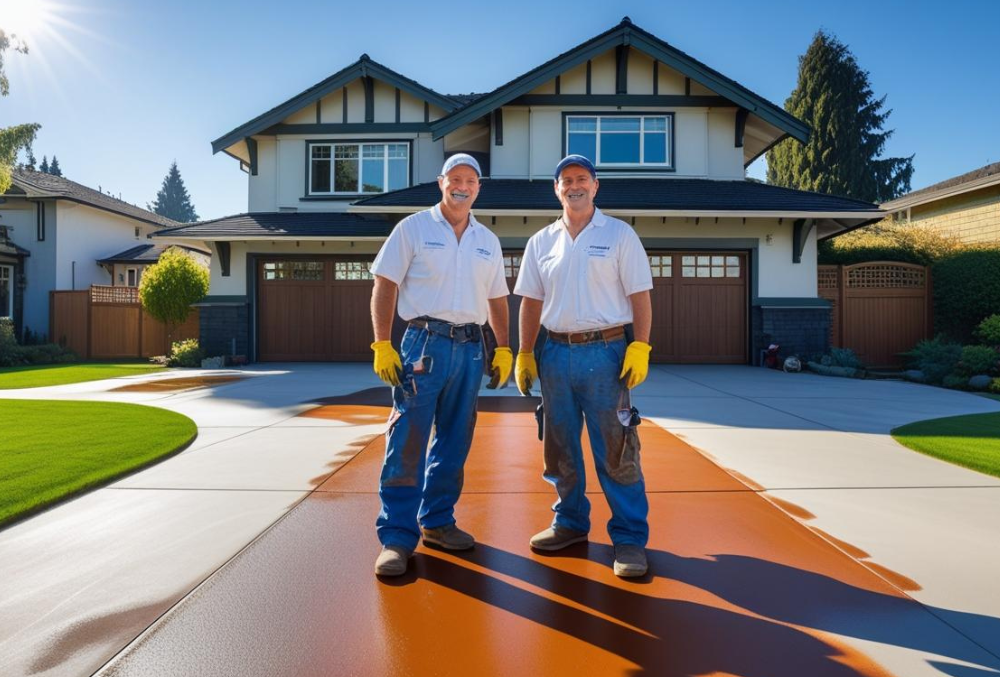
Choosing the appropriate concrete staining contractor is essential for attaining optimal results in flooring projects, whether considering custom designs or environmental considerations, and several key factors should inform your decision-making process.
First and foremost, it is important to evaluate the contractor’s experience and expertise in concrete staining, along with their reputation within the industry. Reviewing their portfolio and references can offer valuable insights into the quality of their work.
Additionally, effective customer service and communication are critical components that can greatly enhance the overall experience throughout the duration of the project.
Experience and Expertise in Contractor Services
When selecting a concrete staining contractor, it is imperative to consider their experience and expertise, as these factors have a direct impact on the quality of the final project.
Experienced contractors possess the technical knowledge required to handle various types of concrete surfaces and staining techniques, ensuring that they can achieve the desired aesthetic outcomes while effectively addressing any challenges that may arise during the process.
Their familiarity with industry standards and best practices is crucial for delivering a high-quality, durable result.
Evaluating a contractor’s background, including their portfolio and client testimonials, can provide valuable insights into their past work and overall reliability.
A thorough assessment of a contractor’s qualifications not only enhances project outcomes but also fosters a smooth working relationship, ultimately leading to a successful transformation of the concrete surface. Making an informed choice can significantly improve both aesthetic appeal and durability, ensuring the project withstands the test of time.
Portfolio and References
A contractor’s portfolio and references serve as essential tools for evaluating their capabilities and the quality of their work as a concrete staining contractor. By examining project examples and case studies, prospective clients can assess the contractor’s design style, attention to detail, and overall craftsmanship.
Additionally, seeking references from previous clients offers valuable insights into the contractor’s reliability, professionalism, and communication skills throughout the project duration.
Reviewing a contractor’s portfolio enables clients to visualize how their specific needs may be met, fostering an understanding of the range of services offered. This assessment not only enhances appreciation for the contractor’s artistic abilities but also highlights the breadth of their experience in diverse environments, including both residential and commercial settings.
Quality of Materials and Equipment
The quality of materials and equipment utilized by concrete staining contractors is a critical factor that directly influences the durability and appearance of the completed project, especially when considering the cost to stain concrete.
When assessing potential contractors, it is essential for homeowners to acknowledge that the longevity of a stained surface often depends on the quality and compatibility of the materials used. Premium materials, including high-grade stains and superior sealers, not only enhance the visual appeal but also provide crucial protection against weathering and wear.
Customer Service and Communication
Effective customer service and communication are essential components of the success of any concrete staining project, as they promote a positive working relationship between the contractor and the client.
A contractor who prioritizes clear communication is better positioned to understand the client’s vision, address concerns promptly, and provide valuable updates throughout the project. Excellent customer service also ensures that the contractor remains accountable, resulting in a smoother and more satisfactory project experience.
In the contracting industry, the importance of robust customer service cannot be overstated. The ongoing exchange of information not only clarifies expectations but also fosters trust, which is vital for effective collaboration. When clients feel valued and understood, they are more likely to share their goals and preferences openly.
This transparency cultivates a mutually beneficial relationship, enabling the contractor to tailor their approach more effectively. Effective communication reduces the likelihood of misunderstandings that can lead to costly delays or revisions.
It is essential to proactively keep clients informed about progress, milestones, and any potential challenges that may arise. Utilizing tools such as regular updates, visual aids, and progress reports can significantly enhance the overall customer experience.
- Transparency cultivates trust and loyalty.
- Informed clients contribute to smoother processes.
- Regular updates help prevent misunderstandings.
What to Expect during the Concrete Staining Process?
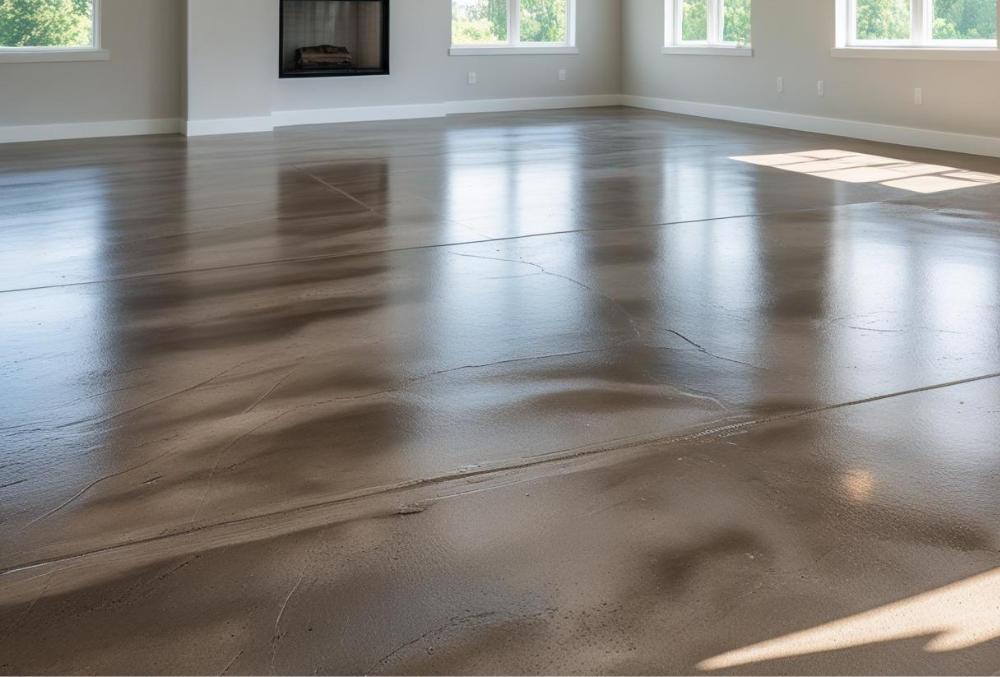
Understanding what to expect during the concrete staining process can assist homeowners in preparing for a seamless project experience. This process typically involves several stages, including surface preparation, stain application, and finishing.
Each stage employs specific techniques to ensure optimal results, and homeowners can anticipate a transformation of their concrete surfaces that enhances both durability and aesthetics, as well as an understanding of maintenance requirements following the staining.
During the initial phase, known as surface preparation, it is essential that the concrete is thoroughly cleaned and any existing coatings or stains are removed to ensure proper adhesion of the new stain. Homeowners may observe that:
- Prior damages, such as cracks or pitting, are addressed before the stain is applied.
- A comprehensive assessment of the surface is critical to achieving the desired appearance.
The next stage is the stain application, where homeowners can select between acid-based or water-based stains, each offering distinct finishes. Once the stain is applied:
- Technicians will evenly distribute the stain to prevent blotchy areas.
- Homeowners can expect to see immediate changes in color and texture.
The finishing process involves sealing the stained surface to enhance its longevity and increase its resistance to damage. At this stage, homeowners will be informed about:
- Recommended products for sealing the stain.
- Tips for ongoing maintenance to preserve the beauty of the stained surface.
Being aware of each stage facilitates informed collaboration with professionals, ultimately leading to a successful and satisfying outcome.
How to Maintain Stained Concrete Floors?

Maintaining stained concrete floors is crucial for preserving their aesthetic appeal and longevity. Fortunately, the maintenance requirements are relatively straightforward and manageable.
Regular cleaning with products specifically formulated for stained concrete, along with periodic resealing, can significantly enhance both the durability and appearance of the flooring.
Homeowners can implement simple DIY maintenance strategies to keep their stained concrete looking fresh and vibrant, thereby ensuring that their investment continues to provide aesthetic value over time.
A fundamental aspect of stained concrete floor maintenance is the establishment of a consistent cleaning routine. Weekly dust mopping is effective in preventing dirt accumulation, while monthly deep cleaning with pH-neutral cleaners ensures that the surface maintains its sheen without compromising the integrity of the stain.
For more challenging stains, homeowners may consider using a diluted solution of dish soap and water, or a specialized concrete cleaner, applied with a soft-bristle brush.
Resealing should be performed every 1 to 3 years, depending on the level of foot traffic and wear. Utilizing a high-quality penetrating sealer can enhance the floor’s resistance to stains and moisture. It is advisable to test any new product on a small, inconspicuous area prior to application to ensure compatibility with the stained surface.





